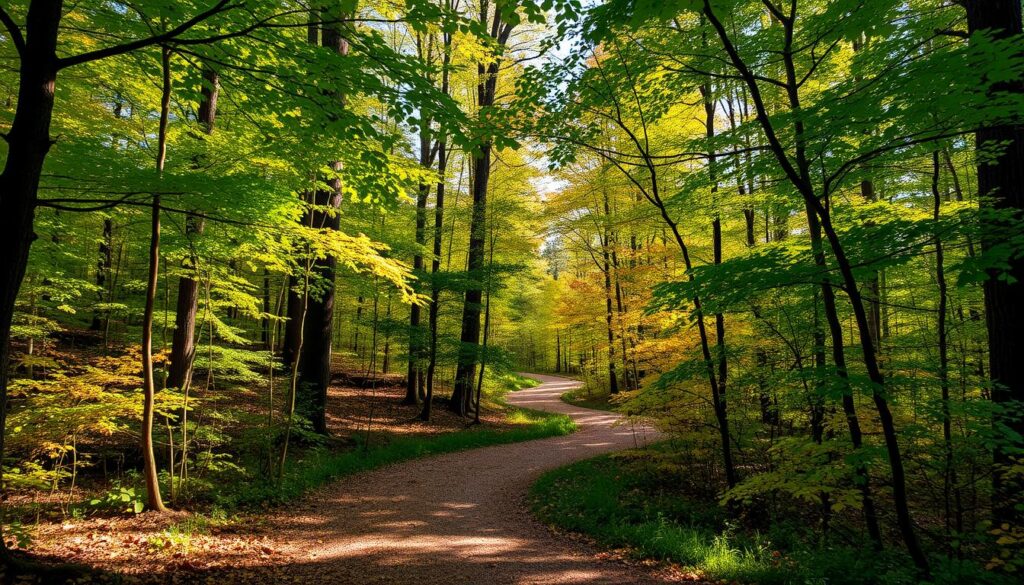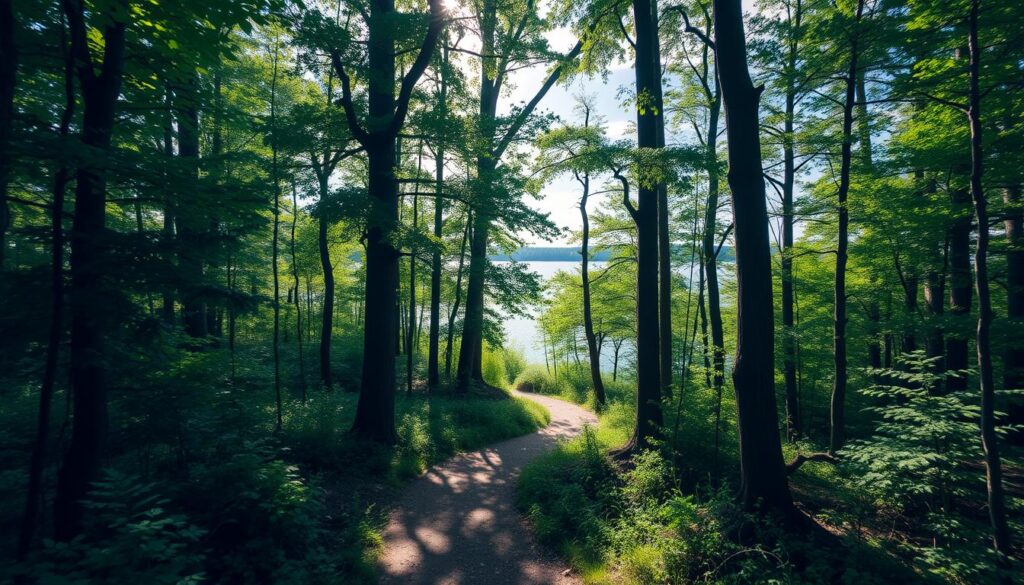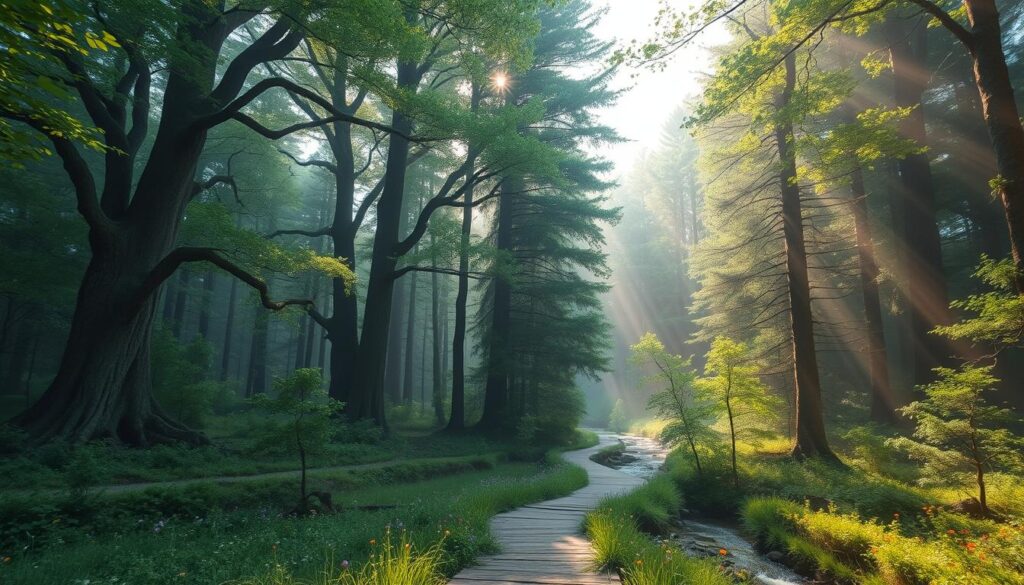In north-central Minnesota, there’s a special place called the Minnesota Lost 40. It’s 144 acres of old-growth forest. This area was saved by a mistake in 1882, when it was thought to be part of a logging area. Now, it’s a quiet spot where you can see huge red and white pines.
These trees are really old and some are almost 4 feet wide. The Minnesota Lost 40 lets you see what Minnesota was like a long time ago. You can walk a 1-mile trail or go snowshoeing in winter.
It’s perfect for anyone who loves nature, photography, or just wants a quiet place. The Minnesota Lost 40 is a special place that will stay with you.
Key Takeaways
- The Minnesota Lost 40 is a 144-acre patch of old-growth forest within the Chippewa National Forest in north-central Minnesota.
- The forest contains red and white pines that are over 200 years old, with some trees reaching nearly 4 feet in diameter.
- A 1882 survey error saved the Lost 40 from clear-cut logging, preserving it as a living snapshot of the past.
- The Lost 40 offers a 1-mile interpretive trail loop for hiking, snowshoeing, and birdwatching.
- This hidden gem showcases the remarkable history and natural diversity of Minnesota’s forestry heritage.
Discovering the Historic Legacy of Minnesota Lost 40
In the Chippewa National Forest, there’s a special place called the Minnesota Lost 40. It’s 144 acres of old-growth forest. A lucky mistake saved it, showing Minnesota’s logging history and nature’s strength.
Origins of the 1882 Survey Error
In 1882, a survey mistake saved the Lost 40. It was thought to be a lake, avoiding logging. This error kept one of Minnesota’s oldest forests safe, with trees over 400 years old.
Preservation of Old-Growth Forest
For over a century, the Lost 40 has been untouched. Its ancient trees, up to 48 inches wide, show Minnesota’s natural beauty. They remind us of the area before logging.
Historical Significance in Minnesota’s Logging Era
The Lost 40 is key to understanding Minnesota’s logging past. Towns like Deer River and Grand Rapids grew, with logging camps everywhere. The Lost 40 lets us see how logging changed the state.
The minnesota blowout game and minnesota crushing loss might be famous. But the Minnesota Lost 40 is a treasure, showing the state’s natural and cultural wonders.
Location and Access to this Hidden Forest Gem
The Minnesota Lost 40 Scientific and Natural Area is a hidden gem in Itasca County. It’s 53 miles north of Grand Rapids. To get there, take Highway 26 and follow forest road 2240, near Northome.
The gravel road is usually good but can get rough in winter. You’ll find parking and vault restrooms at the start. But, there’s no drinking water or garbage facilities.
| Destination | Distance | Time |
|---|---|---|
| Grand Rapids, MN | 53 miles | 1 hour 10 minutes |
| Northome, MN | 8 miles | 15 minutes |
| Bemidji, MN | 70 miles | 1 hour 20 minutes |
Are you a hiker, nature lover, or just looking to get away? The Lost 40 offers a unique outdoor adventure.
“This hidden forest gem is a true sanctuary, offering a rare glimpse into Minnesota’s untamed natural beauty.”
Ancient Giants: The Remarkable Trees of Lost 40
The Lost 40 Scientific and Natural Area is in the Chippewa National Forest. It has some of the biggest white and red pine trees in Minnesota. This forest was missed by loggers because of a mistake in the late 1800s and early 1900s.
Now, it’s a home for ancient trees that have lived for a long time.
White Pine Champions
The white pines in the Lost 40 are amazing. They grow over 100 feet tall. This makes a beautiful canopy that filters the sunlight.
It takes at least three people to wrap their arms around these huge trees.
Red Pine Records and Statistics
The Lost 40 has some of the biggest red pine trees in Minnesota. The “Big Tree Champion” is 120 feet tall. It has a trunk that’s 115 inches around.
Many red pines here are over 200 years old. Some are even over 300 years old.
Tree Age and Size Distribution
The trees in the Lost 40 are very old. Most are about 250 years old. This is much older than the 120-year minimum for old-growth trees in Minnesota.
This forest is a rare example of Minnesota’s old-growth forests. Now, only about 5% of the forests are like this.
The Lost 40 is a natural wonder and a living museum. It shows how long Minnesota’s white and red pines can live. These trees remind us of the need to protect our natural heritage and old-growth forests.
Seasonal Activities and Trail Information
The minnesota lost 40 is in the Chippewa National Forest. It’s a place for fun all year. The 1-mile trail lets you see the beauty of old-growth forests.
In summer, the minnesota lost 40 is full of wildflowers. Hikers see tall white and red pines. There’s also a shorter loop to see big trees.
In winter, it’s a snow wonderland. You can snowshoe or ski here. The trail is good for all skill levels.
“The Lost Forty is a true treasure trove of natural wonders, offering a glimpse into Minnesota’s untouched past. Whether you’re hiking in the summer or gliding through the snow in winter, the experience is truly unforgettable.”

Make sure to check the trail before you go. The minnesota lost 40 is great for nature lovers. It’s a special place to see Minnesota’s beauty.
Wildlife and Natural Diversity in Minnesota Lost 40
The Lost 40 is a hidden forest gem in Minnesota. It’s full of birdwatching spots and native plants. This place shows off the state’s rich biodiversity.
Bird Watching Opportunities
The Lost 40 is home to many bird species all year. You can see bald eagles and hear warblers and thrushes. It’s a birdwatcher’s dream with over 30 new species found here.
Native Plant Species
The Lost 40 has a wide range of native plants. In summer, wildflowers bloom, showing off the forest’s beauty. These plants grow among tall white and red pines.
Ecosystem Characteristics
The Lost 40 is a rare old-growth forest in Minnesota. It has many acres of untouched peatlands. This supports a lot of plants and animals.
For birders, nature lovers, or anyone wanting peace, the Lost 40 is perfect. It offers a unique experience away from the usual news.
Planning Your Visit: Essential Information
When you go to the Minnesota Lost 40, know that there are no many facilities. You can’t camp, have campfires, or use motors. Also, no rock collecting or plant picking is allowed.
Make sure to bring your own water and take all trash with you. The summer is great for seeing wildflowers. Fall is amazing for the colors. Winter is special for snowshoeing.
- Camping and campfires are not allowed
- Motorized activities, rock collecting, and plant harvesting are prohibited
- Bring your own drinking water and pack out all trash
- Summer and fall offer the best seasons for visiting
- Winter provides a magical snowshoeing experience
Plan well and follow the rules for a great Minnesota Lost 40 trip. Enjoy the quiet beauty of this forest. Make memories that will last forever.

Photography and Scenic Viewpoints
The Minnesota Lost 40 is a paradise for photographers. It offers many chances to capture the beauty of this ancient forest. Whether you’re a pro or just love nature, the Lost 40’s changing landscapes inspire amazing photos.
Best Photo Locations
The Lost 40 has many great spots for photos. Some top places include:
- The towering old-growth white pine trees, some reaching heights of 130 feet and estimated to be over 300 years old.
- The vibrant fall foliage, as the surrounding maple and birch trees transform the forest into a blaze of color each autumn.
- The serene snow-covered landscape in winter, accentuating the majestic silhouettes of the evergreen pines.
- The natural wetlands and peatlands bordering the forest, home to a wealth of plant and wildlife diversity.
Lighting and Seasonal Considerations
Lighting is key in nature photography. In the Lost 40, the best light changes with the day and seasons. Early morning and late afternoon give soft, warm light that highlights the pines. Midday sun can create harsh shadows.
Fall brings stunning colors, while winter snow adds a magical touch. Always check the lighting to capture the Lost 40’s beauty.
Conservation Efforts and Forest Management
The Minnesota Lost 40 is a special place in the state’s forests. It’s managed by the U.S. Forest Service and the Minnesota Department of Natural Resources. They work together to keep the old-growth forest as it is, for future generations.
Visitors are asked to follow the Leave No Trace rules. This helps keep the forest in good shape. By doing so, you help the forest stay healthy and full of life.
The Lost 40 is in the Laurentian Mixed Forest Province. This area is known for its beauty and importance to nature. It has many different types of habitats, like bogs and tall pine forests.
Minnesota’s forests cover a lot of land. They are important for the economy and jobs. The work done in the Lost 40 shows Minnesota’s care for the environment.
Minnesota is working hard to protect its forests. Programs like One Watershed, One Plan and Easement Programs help a lot. They aim to keep places like the minnesota lost 40 safe for the future.
Nearby Attractions and Accommodations
Outside the Lost 40 forest, Minnesota has lots to see and places to stay. You can try local food, go on adventures, and more. There’s something fun for everyone.
Local Dining Options
In towns like Bemidji, Blackduck, and Cass Lake, you’ll find great places to eat. The Minnesota Nice Cafe in Bemidji is loved by locals. It serves tasty meals and has friendly service.
Looking for breakfast, lunch, or dinner? The local food scene has it all.
Lodging Recommendations
The Northwoods around the Lost 40 have many places to stay. You can choose from cozy cabins to resorts by the lake. The Hill Motel, for instance, has rooms for 1 to 11 people. It’s close to fishing spots and ATV trails.
There are also campgrounds, vacation rentals, and inns in the area. You can find the perfect spot for your stay near the Lost 40.
There’s more to see beyond the Lost 40. You can play golf, bowl, visit casinos, or explore the Chippewa National Forest. The Bemidji, Blackduck, and Cass Lake areas have lots to offer. They have something for everyone, whether you love the outdoors, culture, or just relaxing.
Conclusion
The Minnesota Lost 40 is a special place that shows off the state’s natural beauty. It was saved by a mistake in 1882. Now, it’s a treasure in Minnesota’s Northwoods.
Are you into old-growth forests, outdoor fun, or just nature? The Lost 40 has it all. You’ll see tall pines, animals, and plants. It’s a secret world waiting for you.
The story of the Minnesota Lost 40 teaches us about chance and saving nature. When you visit, think about its importance. It’s a chance to see nature’s beauty and learn about our world.


A Life-Changing Experience with This Weight Loss Supplement (Nagano Tonic)
I’ve always struggled with finding a weight loss solution that actually works for me. Like many, I’ve tried numerous diets, exercise routines, and supplements over the years—some worked for a short time, but nothing ever gave me long-term results. That was until I decided to try the weight loss supplement I found : Link to the Supplement.
From the moment I started using it, I noticed a difference. Not only did I feel more energized, but my cravings also became more manageable. The best part? I started seeing results much quicker than I anticipated! Over the course of just a few weeks, I noticed a significant reduction in belly fat and overall weight loss that I hadn’t been able to achieve before.
What makes this supplement stand out from all the others I’ve tried is how it supports me in my daily routine without any jitters or energy crashes. I’m able to stay focused and motivated, which has made it easier to stay on track with my diet and exercise plan.
This product truly exceeded my expectations, and I feel more confident and healthier than ever before. If you’re struggling with your weight loss journey like I was, I highly recommend giving this supplement a try. It’s been a game-changer for me, and I’m sure it can work wonders for you too!
Contant Them on email .. tonicnagano50@gmail.com
I’ve tried so many weight loss products over the years, but nothing worked like this supplement! Since I started using it, I’ve noticed a big difference in my energy levels and appetite control. In just a few weeks, I’ve lost weight and feel so much better. It’s been easy to stick with, and the results speak for themselves. Highly recommend this to anyone looking to make a real change!
wasn’t sure what to expect, but this weight loss supplement has really impressed me! After just a few weeks of use, I’ve already dropped a few pounds and feel more motivated to stay active. It’s helped curb my cravings and boosted my energy throughout the day. I’m excited to keep going and see even better results. Definitely worth trying!
Reach them on tonicnagano50@gmail.com
I was skeptical at first, but this supplement has truly made a difference in my weight loss journey. I’ve lost weight without feeling deprived or sluggish. My cravings are under control, and I feel more confident in my body. It’s easy to incorporate into my daily routine, and the results speak for themselves. I’m so glad I gave it a try!
Thanks David, i do use the link to make my purchase. you can get too here http://surl.li/iasppy
I’ve tried so many weight loss products, but this one has been by far the most effective. In just a few weeks, I’ve noticed a visible difference in my body and energy levels. It’s helped me stay on track without the constant hunger pangs and cravings. I’m really happy with my progress and can’t wait to see where I’ll be in another month!